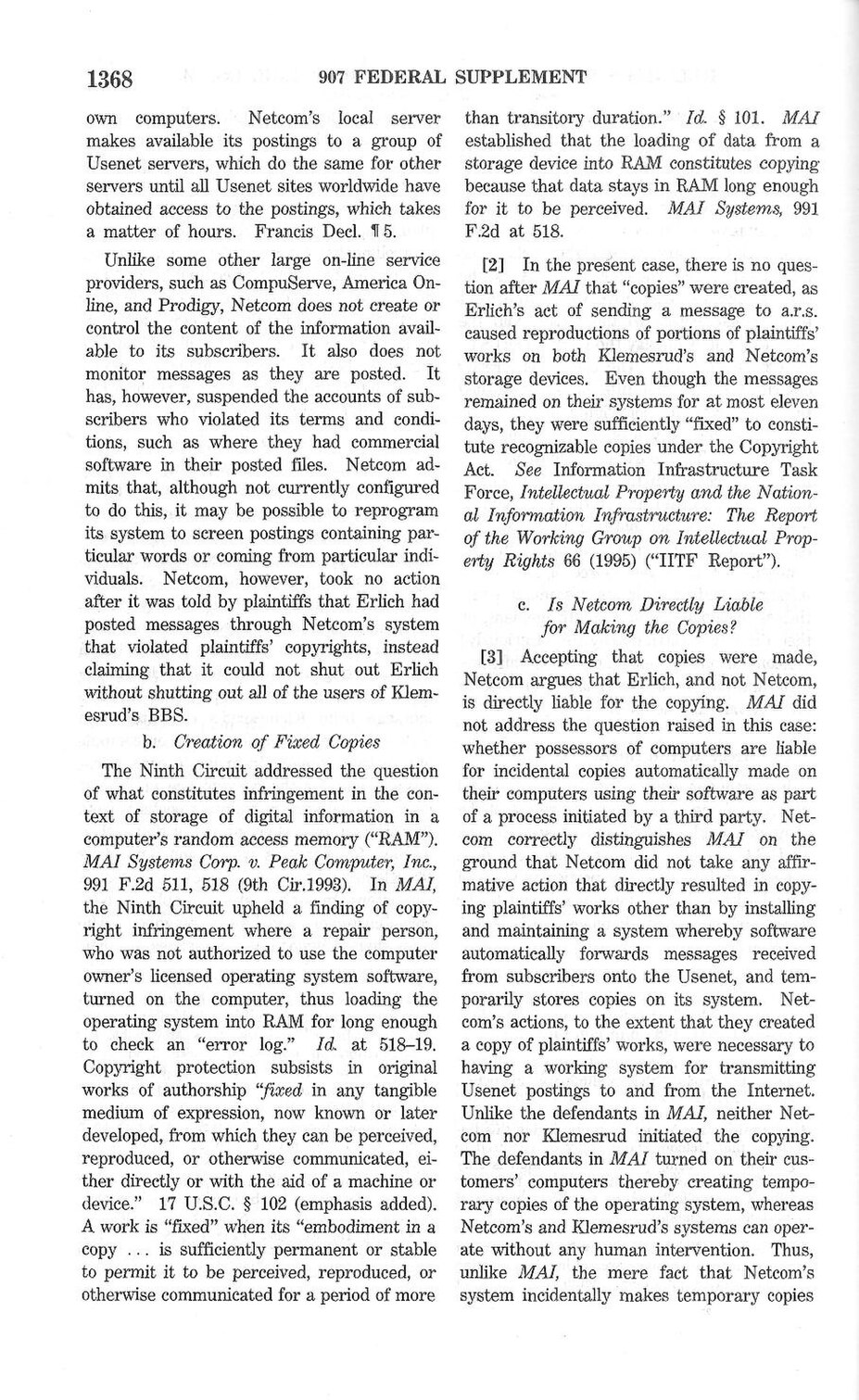own computers. Netcom’s local server makes available its postings to a group of Usenet servers, which do the same for other servers until all Usenet sites worldwide have obtained access to the postings, which takes a matter of hours. Francis Decl. ¶5.
Unlike some other large on-line service providers, such as CompuServe, America Online, and Prodigy, Netcom does not create or control the content of the information available to its subscribers. It also does not monitor messages as they are posted. It has, however, suspended the accounts of subscribers who violated its terms and conditions, such as where they had commercial software in their posted files. Netcom admits that, although not currently configured to do this, it may be possible to reprogram its system to screen postings containing particular words or coming from particular individuals. Netcom, however, took no action after it was told by plaintiffs that Erlich had posted messages through Netcom’s system that violated plaintiffs’ copyrights, instead claiming that it could not shut out Erlich without shutting out all of the users of Klemesrud’s BBS.
b. Creation of Fixed Copies
The Ninth Circuit addressed the question of what constitutes infringement in the context of storage of digital information in a computer’s random access memory (“RAM”). MAI Systems Corp. v. Peak Computer, Inc., 991 F.2d 511, 518 (9th Cir.1993). In MAI, the Ninth Circuit upheld a finding of copyright infringement where a repair person, who was not authorized to use the computer owner’s licensed operating system software, turned on the computer, thus loading the operating system into RAM for long enough to check an “error log.” Id. at 518–19. Copyright protection subsists in original works of authorship “fixed in any tangible medium of expression, now known or later developed, from which they can be perceived, reproduced, or otherwise communicated, either directly or with the aid of a machine or device.” 17 U.S.C. § 102 (emphasis added). A work is “fixed” when its “embodiment in a copy … is sufficiently permanent or stable to permit it to be perceived, reproduced, or otherwise communicated for a period of more than transitory duration.” Id. § 101. MAI established that the loading of data from a storage device into RAM constitutes copying because that data stays in RAM long enough for it to be perceived. MAI Systems, 991 F.2d at 518.
In the present case, there is no question after MAI that “copies” were created, as Erlich’s act of sending a message to a.r.s. caused reproductions of portions of plaintiffs’ works on both Klemesrud’s and Netcom’s storage devices. Even though the messages remained on their systems for at most eleven days, they were sufficiently “fixed” to constitute recognizable copies under the Copyright Act. See Information Infrastructure Task Force, Intellectual Property and the National Information Infrastructure: The Report of the Working Group on Intellectual Property Rights 66 (1995) (“IITF Report”).
c. Is Netcom Directly Liable for Making the Copies?
Accepting that copies were made, Netcom argues that Erlich, and not Netcom, is directly liable for the copying. MAI did not address the question raised in this case: whether possessors of computers are liable for incidental copies automatically made on their computers using their software as part of a process initiated by a third party. Netcom correctly distinguishes MAI on the ground that Netcom did not take any affirmative action that directly resulted in copying plaintiffs’ works other than by installing and maintaining a system whereby software automatically forwards messages received from subscribers onto the Usenet, and temporarily stores copies on its system. Netcom’s actions, to the extent that they created a copy of plaintiffs’ works, were necessary to having a working system for transmitting Usenet postings to and from the Internet. Unlike the defendants in MAI, neither Netcom nor Klemesrud initiated the copying. The defendants in MAI turned on their customers’ computers thereby creating temporary copies of the operating system, whereas Netcom’s and Klemesrud’s systems can operate without any human intervention. Thus, unlike MAI, the mere fact that Netcom’s system incidentally makes temporary copies
